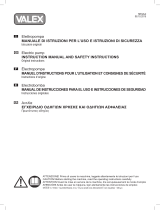
8
ITALIANOITALIANO
8 COLLEGAMENTI ELETTRICI
ATTENZIONE! OSSERVARE SEMPRE LE NORME DI SICUREZZA!
L’installazione elettrica deve essere effettuata da un elettricista esperto, autorizzato che se ne assume tutte le respon-
sabilità.
Assicurarsi che la tensione di rete corrisponda a quella di targa del motore da alimentare e che sia possibile ESEGUIRE UN
BUON COLLEGAMENTO DI TERRA.
Verificare la corrispondenza tra i dati di targa ed i valori nominali di linea.
Effettuare il collegamento (assicurandosi dell’esistenza di un efficace circuito di terra) secondo lo schema riportato sotto il copri-
basetta o in targa. Il conduttore di terra deve essere più lungo dei conduttori di fase e deve essere il primo ad essere connesso
durante il montaggio e l’ultimo ad essere staccato in fase di smontaggio. Si raccomanda di dedicare una linea elettrica privilegiata
per il collegamento dell’ elettropompa. Installare a monte dell’elettropompa un interruttore differenziale magnetotermico riserva-
to esclusivamente all’alimentazione della pompa, con corrente residua di (IΔN) ≤30mA. Installare un dispositivo per la disinserzione
onnipolare dalla rete (interruttore per scollegare
la pompa dall’alimentazione). Nelle pompe monofase fino a 1,5 kW il motore è protetto dai sovraccarichi mediante dispositivo ter-
mico (salvamotore) inserito nell’avvolgimento.
Installare nel quadro di comando un adeguato salvamotore con curva come da corrente di targa. Con le elettropompe trifasi,
quando non è possibile controllare a vista il livello dell’acqua, installare un interruttore a galleggiante collegato al quadro di coman-
do per stabilire i livelli di arresto e di avviamento automatico. I termoprotettori, nei motori trifasi, proteggono dal sovraccarico e
non dalla marcia a motore bloccato,il quadro di comando deve prevedere quindi idoneo relè termoamperometrico accoppiato al
contattore di comando. I motori trifase devono essere protetti a cura dell’utente. Nei motori trifase accertarsi che il senso
di rotazione sia orario guardando la pompa dal lato ventola motore; in caso contrario invertire due fasi.
Se la scatola morsetti è munita di pressacavo, usare un cavo di alimentazione flessibile tipo H07 RN-F
con sezione del cavo pari o superiore.
ADESCAMENTO
ATTENZIONE: il funzionamento a secco della pompa causa danni alla tenuta meccanica.
Questa operazione si esegue attraverso il tappo di adescamento riempiendo il corpo pompa con il liquido da pompare. Ad
operazione eseguita, riavvitare il tappo e far partire la pompa.
ATTENZIONE: se dopo una decina di minuti la pompa non si fosse adescata, spegnerla e ripetere l’operazione.
L’adescamento deve essere ripetuto oqni qualvolta la pompa sia rimasta inoperante per lunghi periodi.
9 SICUREZZA
Prima di qualsiasi intervento di controllo o manutenzione, togliere tensione all’impianto e staccare la
spina dalla presa.
Prima dell’installazione, assicurarsi che la rete di alimentazione sia dotata di messa a terra e conforme alle norme.
Durante il funzionamento il motore può essere caldo, porre attenzione.
Non sono adatte al pompaggio di liquidi infiammabili o ad operare in ambienti con pericolo di esplosione.
Evitare il contatto tra l’alimentazione elettrica e il liquido da pompare.
Non modificare i componenti dell’elettropompa.
L’apparecchio non deve essere utilizzato da persone (inclusi bambini) con capacità fisiche, sensoriali o mentali ridotte, o
mancanza di esperienza e conoscenza, a meno che non siano stati supervisionati o istruiti, i bambini devono essere sorve-
gliati per non giocare con l’apparecchio
10 MANUNTENZIONE
Prima di ogni intervento, assicurarsi che la tensione sia staccata e non ci siano possibilità di connessioni
accidentali. Riparare o far riparare la pompa da personale non autorizzato dalla Ditta Costruttrice signifi-
ca perdere la garanzia e operare con attrezzature insicure e potenzialmente pericolose.
ATTENZIONE: ogni manomissione può portare al decadimento delle prestazioni e pericolo per persone e/o
cose.
Le pompe non richiedono alcuna manutenzione, purchè siano prese le seguenti precauzioni: Ove vi siano rischi di gelate svuo-
tare la pompa avendo cura di riadescarla al successivo avviamento. Verificare sovente che la valvola di fondo sia pulita. Se
la pompa deve rimanere inutilizzata per lungo tempo (esempio: periodo invernale), è consigliabile svuotarla completamente,
risciacquarla con acqua pulita e riporla in luogo asciutto.
CONTROLLO ROTAZIONE ALBERO MOTORE
Nel caso l’albero non ruoti liberamente, provvedere allo sbloccaggio mediante un cacciavite inserito nell’apposito intaglio
praticato nell’albero dal lato ventola. Ove ciò non bastasse rimuovere il corpo pompa togliendo le viti di fissaggio e procedere
ad una pulizia per rimuovere eventuali incrostazioni.

















